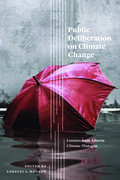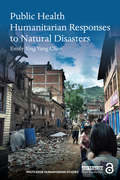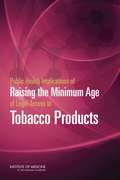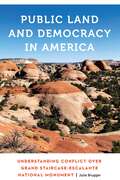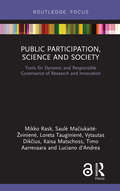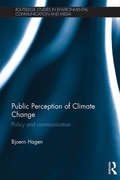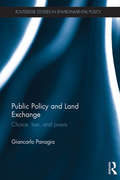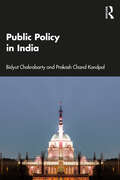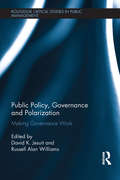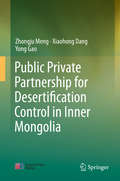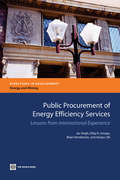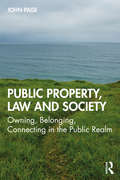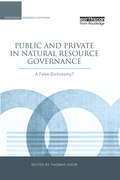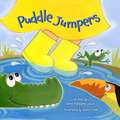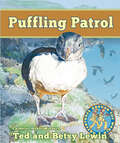- Table View
- List View
Public Brainpower
by Indra OverlandThis book examines how civil society, public debate and freedom of speech affect natural resource governance. Drawing on the theories of Robert Dahl, Jurgen Habermas and Robert Putnam, the book introduces the concept of 'public brainpower', proposing that good institutions require: fertile public debate involving many and varied contributors to provide a broad base for conceiving new institutions; checks and balances on existing institutions; and the continuous dynamic evolution of institutions as the needs of society change. The book explores the strength of these ideas through case studies of 18 oil and gas-producing countries: Algeria, Angola, Azerbaijan, Canada, Colombia, Egypt, Iraq, Kazakhstan, Libya, Netherlands, Nigeria, Norway, Qatar, Russia, Saudi, UAE, UK and Venezuela. The concluding chapter includes 10 tenets on how states can maximize their public brainpower, and a ranking of 33 resource-rich countries and the degree to which they succeed in doing so. The Introduction and the chapters 'Norway: Public Debate and the Management of Petroleum Resources and Revenues', 'Kazakhstan: Civil Society and Natural-Resource Policy in Kazakhstan', and 'Russia: Public Debate and the Petroleum Sector' of this book are available open access under a CC BY 4. 0 license at link. springer. com.
Public Deliberation on Climate Change: Lessons from Alberta Climate Dialogue
by Lorelei L. Hanson David KahaneThere exists in both academic and political circles a growing interest in public deliberation as an alternative to the sometimes adversarial and polarizing public engagement activities that result in the pitting of experts against lay people. Proponents of public deliberation claim that a more deliberative process can engage a diversity of participants in a more guided process that better balances expert knowledge and citizen inclusion. Such an approach holds particular promise where citizens and governments engage in discussions of the most complex and intractable issues like climate change. Given the host of challenges climate governance presents and the global consequences of our response to them, the experience and knowledge shared by Hanson and the contributors to Public Deliberation on Climate Change provide an important framework for advancing public conversations and processes on this and other wicked problems. The lessons contained in the volume were gained as a result of a five year multidisciplinary, community, university research project called Alberta Climate Dialogue (ABCD), which drew together scholars, practitioners, citizens, civil society members, and government officials from across Alberta at four public deliberations. By highlighting the value tensions and trade-offs and examining the impact that the design of the deliberations has on policy and the creation of conditions that encourage exchange, the contributors aim to build capacity within our institutions and society to find new ways to discuss and solve complex problems.
Public Engagement with Science: Defining the Project (Elements in Public Engagement with Science)
by Angela Potochnik Melissa Jacquart'Public engagement with science' is gaining currency as the framing for outreach activities related to science. However, knowledge bearing on the topic is siloed in a variety of disciplines, and public engagement activities often are conducted without support from relevant theory or familiarity with related activities. This first Element in the Public Engagement with Science series sets the stage for the series by delineating the target of investigation, establishing the importance of cross-disciplinary collaboration and community partnerships for effective public engagement with science, examining the roles public engagement with science plays in academic institutions, and providing initial resources about the theory and practice of public engagement with science. Useful to academics who would like to conduct or study public engagement with science, but also to public engagement practitioners as a window into relevant academic knowledge and cultures. This title is also available as open access on Cambridge Core.
Public Health Humanitarian Responses to Natural Disasters (Routledge Humanitarian Studies)
by Emily Ying ChanThe pressure of climate change, environmental degradation, and urbanisation, as well as the widening of socio- economic disparities have rendered the global population increasingly vulnerable to the impact of natural disasters. With a primary focus on medical and public health humanitarian response to disasters, Public Health Humanitarian Responses to Natural Disasters provides a timely critical analysis of public health responses to natural disasters. Using a number of case studies and examples of innovative disaster response measures developed by international agencies and stakeholders, this book illustrates how theoretical understanding of public health issues can be practically applied in the context of humanitarian relief response. Starting with an introduction to public health principles within the context of medical and public health disaster and humanitarian response, the book goes on to explore key trends, threats and challenges in contemporary disaster medical response. This book provides a comprehensive overview of an emergent discipline and offers a unique multidisciplinary perspective across a range of relevant topics including the concepts of disaster preparedness and resilience, and key challenges in human health needs for the twenty-first century. This book will be of interest to students of public health, disaster and emergency medicine and development studies, as well as to development and medical practitioners working within NGOs, development agencies, health authorities and public administration.
Public Health Implications of Raising the Minimum Age of Legal Access to Tobacco Products
by Richard J. BonnieTobacco use by adolescents and young adults poses serious concerns. Nearly all adults who have ever smoked daily first tried a cigarette before 26 years of age. Current cigarette use among adults is highest among persons aged 21 to 25 years. The parts of the brain most responsible for cognitive and psychosocial maturity continue to develop and change through young adulthood, and adolescent brains are uniquely vulnerable to the effects of nicotine. At the request of the U. S. Food and Drug Administration, Public Health Implications of Raising the Minimum Age of Legal Access to Tobacco Products considers the likely public health impact of raising the minimum age for purchasing tobacco products. The report reviews the existing literature on tobacco use patterns, developmental biology and psychology, health effects of tobacco use, and the current landscape regarding youth access laws, including minimum age laws and their enforcement. Based on this literature, the report makes conclusions about the likely effect of raising the minimum age to 19, 21, and 25 years on tobacco use initiation. The report also quantifies the accompanying public health outcomes based on findings from two tobacco use simulation models. According to the report, raising the minimum age of legal access to tobacco products, particularly to ages 21 and 25, will lead to substantial reductions in tobacco use, improve the health of Americans across the lifespan, and save lives. Public Health Implications of Raising the Minimum Age of Legal Access to Tobacco Products will be a valuable reference for federal policy makers and state and local health departments and legislators.
Public Land and Democracy in America: Understanding Conflict over Grand Staircase-Escalante National Monument (Anthropology of Contemporary North America)
by Julie BruggerIn recent years the Grand Staircase-Escalante National Monument in southern Utah has figured prominently in the long and ongoing struggle over the meaning and value of America&’s public lands. In 1996 President Bill Clinton used the Antiquities Act to create the monument, with the goal of protecting scientific and historical resources. His action incensed Utah elected officials and local residents who were neither informed nor consulted beforehand, and opposition to the monument has continued to make its day-to-day management problematic. In 2017 President Donald Trump reduced the monument&’s size, an action immediately challenged by multiple lawsuits; subsequently, President Joe Biden restored the monument in 2021. In Public Land and Democracy in America Julie Brugger brings into focus the perspectives of a variety of groups affected by conflict over the monument, including residents of adjacent communities, ranchers, federal land management agency employees, and environmentalists. In the process of following management disputes at the monument over the years, Brugger considers how conceptions of democracy have shaped and been shaped by the regional landscape and by these disputes. Through this ethnographic evidence, Brugger proposes a concept of democracy that encompasses disparate meanings and experiences, embraces conflict, and suggests a crucial role for public lands in transforming antagonism into agonism.
Public Lands Politics: Interest Group Influence on the Forest Service and the Bureau of Land Management (RFF Forests, Lands, and Recreation Set)
by Paul J. CulhaneFirst Published in 2011. Routledge is an imprint of Taylor & Francis, an informa company.
Public Participation in Environmental Assessment and Decision Making
by National Research Council of the National AcademiesFederal agencies have taken steps to include the public in a wide range of environmental decisions. Although some form of public participation is often required by law, agencies usually have broad discretion about the extent of that involvement. Approaches vary widely, from holding public information-gathering meetings to forming advisory groups to actively including citizens in making and implementing decisions. Proponents of public participation argue that those who must live with the outcome of an environmental decision should have some influence on it. Critics maintain that public participation slows decision making and can lower its quality by including people unfamiliar with the science involved. This book concludes that, when done correctly, public participation improves the quality of federal agencies' decisions about the environment. Well-managed public involvement also increases the legitimacy of decisions in the eyes of those affected by them, which makes it more likely that the decisions will be implemented effectively. This book recommends that agencies recognize public participation as valuable to their objectives, not just as a formality required by the law. It details principles and approaches agencies can use to successfully involve the public.
Public Participation, Science and Society: Tools for Dynamic and Responsible Governance of Research and Innovation
by Timo Aarrevaara Mikko Rask Saulė Mačiukaitė-Žvinienė Loreta Tauginienė Vytautas Dikčius Kaisa Matschoss Luciano d’AndreaThe field of public participation is developing fast, with phenomena such as citizen science and crowdsourcing extending the resource base of research, stimulating innovation and making science more accessible to the general population. Promoting public participation means giving more weight to citizens and civil society actors in the definition of research needs and in the implementation of research and innovation. As yet, there is limited understanding of the implications of widespread use of public participation and as a result, there is a risk that it will become a burden for research and an obstacle to bridging the gap between research and society. This volume presents the findings of a three-year international study on innovative public participation. The resulting work studies the characteristics and trends of innovative public participation through a global sample of 38 case studies. It provides theoretical generalisations on the dynamics of public participation, suggestions for an evaluation framework and clear empirical examples of how public participation works in practice. Illustrated by best practice cases, the authors identify characteristics which contribute to successful public participation. The book is aimed primarily at scholars and practitioners of public participation, as well as research managers, policy makers and business actors interested in related issues. There is also a secondary market for students and scholars of European governance studies, sociology and political sciences.
Public Perception of Climate Change: Policy and Communication (Routledge Studies in Environmental Communication and Media)
by Bjoern HagenDespite the findings on global climate change presented by the scientific community, there remains a significant gap between its recommendations and the actions of the public and policy makers. So far scientists and the media have failed to successfully communicate the urgency of the climate change situation in such a way that long-term, comprehensive, and legally binding policy commitments are being made on the national and international level. This book examines the way the public processes information, how they perceive threats and other perceptual factors that have a significant effect on how and to what degree climate change mitigation and adaptation strategies are supported. Understanding public risk perception plays a vital role in communicating the challenges of global climate change. Using a diverse range of international case studies, this book explores the nature of public perceptions of climate change and identifies the perception factors which have a significant impact on the public’s willingness to support global climate change policies or commit to behavioral changes to reduce greenhouse gas emissions and improve urban resiliency. The comparative study of social and cultural factors, beliefs, attitudes and trust provides an international overview of best practices regarding the design, implementation and generation of public support for climate change policies at a global level. Offering valuable insight into climate change and risk communication, the book should be of interest to students and scholars of environment studies, politics, urban planning, and media and cultural studies.
Public Perceptions of Radiation Effects on Health Risks and Well-Being: A Case of RFEMF Risk Perceptions in Malaysia (SpringerBriefs in Environment, Security, Development and Peace #33)
by Kwan-Hoong Ng Yusniza Kamarulzaman Farrah Dina Yusop Noorhidawati Abdullah Azian MadunThis book reports on the investigation of the public’s perception of Radio Frequency Electromagnetic Field (RF-EMF) radiation effects on health and well-being, in Malaysia. It elaborates on how understanding the impact of perceived risk is essential in order to investigate the explanatory value and effectiveness of interventions influencing these beliefs. The book expands on the knowledge and understanding of different risk perception related to radiation in order to explain the gap in literature regarding the relationship between risk perceptions that lead to public behaviors. In doing so, the book presents empirical findings of a national study that unveils two key factors affecting public risk perceptions: psycho-graphic and personal factors. It offers a more collective and cultural understanding of public perceptions on radiation risks via a systematic mixed-method research approach. Research in the book also show that while the radiation risk is recognizable and unavoidable, the relevant stakeholders should be more proactive and committed to communicate and rectify the perception of radiation. The book thus serves as a valuable source of reference to understand the debate and to invite more participatory dialogues on radiation risk perceptions among public.
Public Policy and Land Exchange: Choice, law, and praxis (Routledge Studies in Environmental Policy)
by Giancarlo PanagiaThis original contribution to the field is the first to bring economic sociology theory to the study of federal land exchanges. By blending public choice theory with engaging case studies that contextualize the tactics used by land developers, this book uses economic sociology to help challenge the under-valuation of federal lands in political decisions. The empirically-based, scholarly analysis of federal-private land swaps exposes serious institutional dysfunctions, which sometimes amount to outright corruption. By evaluating investigative reports of each federal agency case study, the book illustrates the institutional nature of the actors in land swaps and, in particular, the history of U.S. agencies’ promotion of private interests in land exchanges. Using public choice theory to make sense of the privatization of public lands, the book looks in close detail at the federal policies of the Bureau of Land Management and the U.S. Forest Service land swaps in America. These pertinent case studies illustrate the trends to transfer federal lands notwithstanding their flawed value appraisals or interpretation of public interest; thus, violating both the principles of equality in value and observance of specific public policy. The book should be of interest to students and scholars of public land and natural resource management, as well as political science, public policy and land law.
Public Policy in India
by Bidyut Chakrabarty Prakash Chand KandpalThis textbook is a comprehensive, student-friendly guide to public policy in India. It highlights the critical aspects of public policy-making and its implementation by contextualizing it in the Indian historical and modern-day perspective. Public Policy in India: • Provides lucid explanations of theoretical aspects of public policy and its practice in the Indian context; • Captures the complexities in making, implementing and evaluating public policy; • Studies the dialectical interconnection that public policy has with the socio-economic and political environment; • Highlights the influence of culture on public policy; and • Analyses public policy as an outcome of a very complex contextual dialogue involving various kinds of actors. Accessibly written, this book covers a range of university syllabi and will be essential reading for students and researchers of political science and public administration. It will also be indispensable for civil service examinations, including the UPSC.
Public Policy, Governance and Polarization: Making Governance Work (Routledge Critical Studies in Public Management)
by David K. Jesuit and Russell Alan WilliamsPolarization is widely diagnosed as a major cause of the decline of evidence-based policy making and public engagement-based styles of policy making. It creates an environment where hardened partisan viewpoints on major policy questions are less amenable to negotiation, compromise or change. Polarization is not a temporary situation – it is the “new normal.” Public Policy, Governance and Polarization seeks to provide a theoretical foundation for scholars and policy makers who need to understand the powerful and often disruptive forces that have arisen in Europe and North America over the past decade. Academics and practitioners need to better understand this growing trend and to find ways in which it may be managed so that policy solutions to these threats may be developed and implemented. Researchers and future policymakers in fields such as public administration, public management and public policy need to recognise how institutional design, corporatist interest group systems and different pedagogical approaches may help them understand, discuss and work beyond policy polarization. Edited by two leading political science scholars, this book aims to begin that process.
Public Private Partnership for Desertification Control in Inner Mongolia
by Yong Gao Zhongju Meng Xiaohong DangIn terms of China’s current situation, the prevention and control of land degradation and the development of innovative sustainable land management activities lie within the purview of public works. Further, public-private partnerships (PPPs) hold considerable potential for application in this field. Inner Mongolia is one of the Chinese provinces hardest hit by land degradation. Fortunately, after years of dedicated efforts, meaningful achievements have been made: the increasing participation of the people as a whole, combined with growing investments in land degradation prevention and ecological construction on the part of private enterprises, has to some extent compensated for the lack of government involvement. Further, Inner Mongolia has been a pioneer in the use of PPPs for the prevention and control of land degradation, which has yielded numerous ecological, social and economic benefits. To better promote the development of ecological construction and expand the participation in land degradation control, this book systematically studies the use of PPPs in the Inner Mongolia autonomous region, drawing on field investigations and case analyses to do so. Its main goal is to explore a public-private partnership model that can effectively expand the scale of investment in land degradation prevention and sustainable land management.
Public Procurement of Energy Efficiency Services
by Brian Henderson Xiaoyu Shi Dilip R. Limaye Jas SinghThe current universal concerns about global energy security, competitiveness, and environmental protection make energy efficiency more important than ever. However, realizing large-scale savings has proven a significant challenge due to many barriers. 'Public Procurement of Energy Efficiency Services' looks at a largely untapped energy efficiency market - the public sector. While the efficiency potential in this sector is substantial, the implementation of energy savings programs has been complicated by a number of factors, such as insufficient incentives to lower energy costs, rigid budgeting and procurement procedures, and limited access to financing. The book looks at energy savings performance contracts (ESPCs) as a means of overcoming some of these barriers. Because public facilities can outsource the full project cycle to a commercial service provider, ESPCs can enable public agencies to solicit technical solutions, mobilize commercial financing, and assign performance risk to third parties, allowing the agency to pay from a project's actual energy savings. The recommendations in this book stem from case studies that identified approaches, models, and specific solutions to ESPC procurement, including budgeting, energy audits, and bid evaluation. Such an approach also offers enormous potential to bundle, finance, and implement energy efficiency projects on a larger scale in the public sector, which can yield further economies of scale. ESPCs can also serve as an attractive element for fiscal stimulus packages and efforts by governments to 'green' their infrastructure, which can create local jobs, reduce future operating costs, and mitigate their carbon footprint. Lower energy bills, in turn, help to create fiscal space in future years to meet other critical investment priorities. Bundled public sector energy efficiency projects can help stimulate local markets for energy efficiency goods and services and 'lead by example', demonstrating good practices and providing models to the private sector.
Public Property, Law and Society: Owning, Belonging, Connecting in the Public Realm
by John PageThis book examines the almost entirely neglected realm of public property, identifying and describing a number of key organizing principles around which a nascent jurisprudence of public property may be developed. In property law terms, the public realm is lost to plain view. Despite the vast acreage of public lands, or the extensive tracts of private lands over which public rights subsist, there is little commensurate scholarly discussion of the ideas, theories, practices, and laws of public property. This is no accident. Public property has been marginalized and pushed to the periphery for centuries, a consequence of the dominant discourse of private property, and its enclosing, encroaching tendencies. This book explores the rich diversity of the public estate, of what the public realm means for us, the general public, canvassing what we may ‘own’, where we may ‘belong’, or not, and how we may ‘connect’ through a shared use and enjoyment of public place and space. To better understand public property is to better value its critical public-wealth. Whether overlooked, over-used, or under threat of imminent loss, this book maintains that our loved (and not so loved) public spaces are essential components of our diverse, functioning, and optimistically livable human geographies. As such, they demand legal protection. This important and original book will be of considerable interest to scholars and others with interests in property and land law, socio-legal studies, legal geography and urban studies.
Public Waters: Lessons from Wyoming for the American West
by Anne MacKinnonWyoming&’s colorful story of water management illuminates the powerful forces that impact water use in the rural American West. The state&’s rich history of managing this valuable natural resource provides insights and lessons for the twenty-first-century American West as it faces drought and climate change. Public Waters shows how, as popular hopes and dreams meet tough terrain, a central idea that has historically structured water management can guide water policy for Western states today.Drawing on forty years as a journalist with training in water law and economics, Anne MacKinnon paints a lively picture of the arcane twists in the notable record of water law in Wyoming. She maintains that other Western states should examine how local people control water and that states must draw on historical understandings of water as a public resource to find effective approaches to essential water issues in the West.
Public and Private in Natural Resource Governance: A False Dichotomy? (Earthscan Research Editions)
by Thomas Sikor?This volume develops the rich conceptual and empirical content of public-private relationships, increasingly acknowledged as the dominant realm of natural resource governance. Ten wonderful studies from around the world illuminate opportunities for advancing the theory, analysis and effective formation of sustainable systems of resource use. The book is excellent for courses in governance and public policy in any resource and environmental field.? JEFF ROMM, PROFESSOR FOR RESOURCE POLICY, UNIVERSITY OF CALIFORNIA AT BERKELEY, US ?The book addresses the theoretically and politically most important division of social organization into public and private. The authors bring an exciting, multidisciplinary perspective to bear on changing and multiple publics and the strength of relationships connecting these two spheres in rural development and natural resource governance. The contributions range from consumer health and food safety, soil science, forestry and water management to sociological and economic aspects of natural resource property and governance.? FRANZ VON BENDA-BECKMANN, MAX PLANCK INSTITUTE FOR SOCIAL ANTHROPOLOGY, GERMANY Natural resources have historically been considered as being governed in public or private spheres - that is, by the state on behalf of the people, or by companies or individuals driven by the market. This dichotomy between private and public is now recognized as overly simplistic, and it is clear that ?publics? and ?privates? operate at a range of levels and with differing degrees of separation or overlap. Bringing together a group of internationally respected researchers, this book provides a new perspective on prominent issues in resource governance, including the state, NGOs, civil society, communities, participation, devolution, privatization and hybrid institutions, highlighting the three-dimensional nature of relations between ?public? and ?private?. It builds on empirical analyses from six fields of natural resource governance - agri-environment, biodiversity, bioenergy, food quality and safety, forestry and rural water - and employs a comparative approach that goes beyond the specifi cities of individual policy fields, recognizing shared elements and allowing for a greater understanding of the dynamics underlying governance processes. Introductions to the volume and to each section summarize the key debates and highlight linkages between chapters. This is essential reading for academics, students and policy experts in natural resource governance, development and environmental policy.
Puddle Jumpers
by Anne Margaret LewisIt’s a rainy day in the month of May and Sam spots a rainbow, and then a puddle. A perfect spring puddle. His mother warns, "No! No jumping in puddles! You must keep clean today!” but Sam can’t stop himself from testing the water with his galoshes. And then the puddle invites him to play. The puddle whispers, "Jump, Puddle Jumper, jump!” and with that very first jump, Sam is off on an adventure of the imagination. He’ll be a frog in a pond, with a hat and some spots and a magic wand. He’ll be a crocodile with pink polka dots and teeth like blades, and a polar bear with purple polar hair. He’s going to jump, leap, dance, plunge, swim, and jump again. Sam is having so much fun in his puddle that even Mom can’t resist. With a leap and a thwump, she’s jumping too, cheering, "Jump, Puddle Jumper, jump!” This happy picture book celebrates the simple, pure joy of jumping in a rain puddle. Nancy Cote’s cheerful illustrations are full of kid appeal, a perfect match to a story that captures the magic of being a child. Let your imagination take you on your own adventure the next time you encounter an irresistible puddle. Aimed for children ages 3 to 6, this is a charming book about letting your imagination run wild and also about the joys children can find in even just a simple rain puddle. Encouraging kids to explore their outside world provides important developmental play for kids and parents will find the mom's reluctance and then acquiescence a good reminder that adults need to enter the world of children in order to allow them to explore their world and to learn from it.
Puddle Wonderful: Poems to Welcome Spring
by Bobbi Katz Mary MorganChildren's poems that describe the meaning of spring, the delights of rain and mud, the joys of birds and flowers, and other facets of spring. Also discusses April Fool's Day from the point of a dragon-denouncing court jester and considers the Easter Bunny. Poems elaborate on Arbor Day and the custom of spring cleaning. Authors include Eve Merriam, Dennis Lee, Lillian Moore, Jack Prelutsky, and Bobbi Katz. Some ancient quotations are also included.
Puffins (Animals)
by Jaclyn JaycoxPuffins are seabirds with large beaks. They look like a cross between penguins and parrots. Their teeth point backward to help them catch fish. Find out more details about these unique birds.
Puffling Patrol (Adventures Around the World)
by Ted Lewin Betsy LewinTed and Betsy Lewin travel to Iceland to learn about the "Puffling Patrol," a group of children who rescue lost puffins and return them to sea.Every April, the Westman Islands off the coast of Iceland become home to hundreds of thousands of puffins, small black-and-white seabirds with colorful bills. They spend the summer on the rocky cliffs of the islands, caring for their newly hatched chicks. By the middle of August, it is time for the young puffins, called pufflings, to make their way to the sea. And that is when the children of The Puffling Patrol are called to action. Ted and Betsy Lewin have journeyed to the Westman Islands to experience The Puffling Patrol's endeavors firsthand. In the company of Erna, Dáni, and their father, they drive through town at night, carefully searching for confused little birds that have glided down onto the streets instead of out to sea. Will the children find the pufflings before the birds encounter danger? Will the pufflings ever make it to the sea to spend their lives with other puffins in the North Atlantic Ocean? The fascinating story of this unique annual rescue, combined with Ted Lewin's dramatic paintings and Betsy Lewin's lively field sketches, is sure to make Puffling Patrol a hit with animal lovers of all ages.
Pugs in Costumes
by Virginia WoofFrom haute couture Oscar dresses and character classics, superheroes to inanimate objects, there isn't a creature on earth that can rock a costume quite like a pug. With over 100 full color, candid photographs of these adorable dogs in outfits ranging from adorable to hysterical to downright absurd, this book is a pure delight for animal lovers of all stripes.Packed with 128 pages of color photographs, some of the pugs you'll meet in this volume include:- Scarlett O'Pugra- Bob Pugley- Pugzilla- Chewpugca and Pug Vader- Evita Pugron- The Ba HumPug!And many, many more.
Pugs on Rugs
by Jack RussellWhat is it that makes pugs so lovable? Is it their doleful eyes? Their down-turned mouths? Furrowed brows? While they may look sad, they’ve certainly found their place in our homes and our hearts. Now the adorable creatures have a new home, sitting on rugs in 43 amusing photographs! What could be cuter?Pugs on Rugs celebrates different pugs on different rugs. The dog might be walking, sitting, or sleeping and the rug could be Persian, Aztec, or oriental, but the image is guaranteed to be cute and funny!People have been obsessed with pugs for centuries and each of this small book’s spreads features a photograph (or montage) alongside an amusing caption and a fascinating fact about the history and characteristics of this unique breed.Did you know that the first pugs were brought from China to Europe to serve as guard dogs? Or that a famous pug named Pompey once saved a Dutch prince from assassination? Have you heard about the eighteenth-century German secret society dedicated to the pug in which new members initiated themselves by wearing a collar, scratching at the door, and kissing the rear end of a giant porcelain pug? Yes indeed, pug lovers are an interesting breed and this volume is sure to get them laughing with delight.From bullish to pitiful, Pugs on Rugs is a fantastically fun book featuring some of the snuggliest pugs you’ve ever seen.

